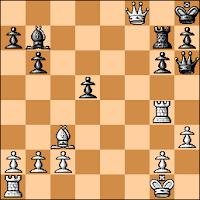In the following game White plays 6.d4 and is immediately hit with the strongest reply, 6...Qh4. Time to panic? Hardly. Simply time to stare the defender right in the eye and ask him: Okay, that's one good move, do you know what comes next??
Darthnik - aufdermaur
blitz, FICS, 2011
1.e4 e5 2.Bc4 Nc6 3.Nf3 Bc5 4.Bxf7+
4...Kxf7 5.Nxe5+ Nxe5 6.d4 Qh4
A full-bore response to White's center play. For recent comments, see "Deus Ex Machina" and "Danger? He Laughs At Danger".
7.0-0 Ng4
Black has mate on his mind, and directs his pieces accordingly.
8.h3 Bd6
Consistent, but 8...Bb6, as in Sir Osis of the Liver - perrypawnpusher, JG3 thematic, ChessWorld, 2008 (0-1, 38) and Wall,B - Rajiv, Chess.com, 2010 (1-0, 33) was probably stronger.
9.e5 Nxe5
Black decides to return a piece for two pawns, to keep the initiative. This may be a slight improvement upon the similarly intentioned 9...Bxe5 which was played in the earliest (to The Database's knowledge) 6...Qh4 game, Sorensen,S - X, Denmark, 1888, (1-0, 27).
Perhaps the patient 9...Be7 was better, still.
10.dxe5 Bxe5
11.f4
A very understandable move from a psychological perspective: White's King has been facing a three-piece onslaught in which Black was comfortable enough to burn one of his own pieces (why not, he still has an extra one) to keep things going. This feels unfair, as White chose the Jerome Gambit to have an attack on Black's King, not the other way around.
White's move blunts the impact of the Bishop, but he had more to expect from 11.Qd5+ putting the focus back on the Black monarch. If Black does not want to simply give a second piece back then he has to try 11...Kf6.
The equalizer for White, then, would be 12.Nd2, intending Ne4+, kicking the protection away from Black's Bishop. Simple development for Black, like 12...Ne7, would even allow the fork trick 13.Qxe5+ Kxe5 14.Nf3+ followed by 15.Nxh4 and material equality. Hanging onto the Bishop for dear life with 12...Qd4, instead, would lead to complications after 13.Qf3+ Ke7 14.Re1, but, again, White will recover his sacrificed piece.
White works this all out a move too late.
11...Bd6 12.Qd5+ Kf8 13.Nd2 Nf6
Now White has to work his attack up all over again. He can be satisfied that Black's "attacking" Bishop has become his "blocking" Bishop, as in blocking Black's own development.
14.Qd3 b6 15.Ne4 Bb7 16.Nxd6 cxd6 17.Qxd6+ Kf7 18.Qd3 Rhe8 19.Bd2 Kg8
The theme looks like it is about to change. Black has castled-by-hand and can look toward attacking White's King again (with an extra piece).
20.f5 Nh5 21.Bc3 Nf4
Aggressive, sure, but overlooking White's counter.
22.Qc4+
This double attack wins back the sacrificed piece. More than that, it seems to distress Black, who again sees his Kingside attack dissolve.
22...Kh8
This move whispers "King safety" but it should have been replaced with 22...d5, since after 23.Qxf4 Qxf4 24.Rxf4 Black can still look toward the drawing chances of a possible Bishops-of-opposite-colors endgame.
Now White's attack roars on.
23.Rxf4 Qh6 24.Rg4 Rg8 25.f6
Thematic, but 25.Re1, planning Re7 with even more pressure on g7, was even stronger.
25...g6 26.f7+ Rg7 27.Qb4 d5 28.f8Q+ Rxf8 29.Qxf8 checkmate
And that, good Readers, is how Darthnik faced the refutation, looked right into its eyes, and stared it down...









No comments:
Post a Comment